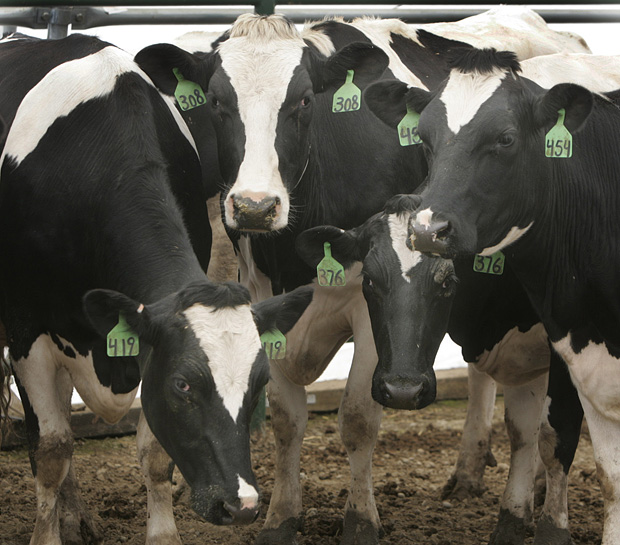Federal regulators shut down a Central California slaughterhouse Monday after receiving undercover video showing dairy cows — some unable to walk — being repeatedly shocked and shot before being slaughtered.
In a few hours, someone in the industry will say, this is an isolated incident and they practice the highest standards of animal welfare and safety.
It’s a tired tune.
People realize the soundbites are meaningless – especially compared to graphic video. It’s like all those food types who say they have really safe food and everyone is worthy of trust and faith, yet outbreaks manage to happen weekly. Industry and academia should be judged by the data they bring to the table, not platitudes.
According to the Associated Press, officials with the U.S. Department of Agriculture, which inspects meat facilities, suspended operations at Central Valley Meat Co. in Hanford, Calif., which slaughters cows when  they lose their value as milk producers.
they lose their value as milk producers.
The USDA received hours of videotape Friday from Compassion Over Killing, an animal welfare group, which said its undercover investigator was employed by the slaughterhouse and made the video over a two-week period in June.
Four minutes of excerpts the animal welfare group provided to The Associated Press showed cows being prepared for slaughter. One worker appears to be suffocating a cow by standing on its muzzle after a gun that injects a bolt into the animal’s head had failed to render it unconscious. In another clip, a cow is still conscious and flailing as a conveyor lifts it by one leg for transport to an area where the animals’ throats are slit for blood draining.
"The horror caught on camera is sickening," said Erica Meier, executive director of Compassion Over Killing, based in Washington, D.C. "It’s alarming that this is not only a USDA-inspected facility but a supplier to the USDA."
Within hours of seeing the video, the USDA’s Office of Inspector General sent investigators who found evidence of "egregious inhumane handling and treatment of livestock."
The USDA had at least two inspectors stationed at the site, and federal officials, when asked whether there was evidence the inspectors had neglected their duties, said the investigation is ongoing.
The videos show workers pulling downed cows by their tails and kicking them in an apparent attempt to get them to stand and walk to slaughter. Others shoot downed cows in the head over and over as the cows thrash on the ground. In one instance, the video shows workers trying to get cattle to back out of a chute while repeatedly spraying them with water and shocking them.
"It’s a good sign that the USDA is taking this seriously, but I want to see what comes next," said Meier, adding the video will be posted on the organization’s website Tuesday. "The footage clearly speaks for itself, but this is not an isolated incident. Investigation after investigation of these places is revealing cruelty."
In early 2008, the Humane Society of the United States released video documenting animal abuse at Hallmark/Westland Meat Packing Co. of Chino, Calif., secretly shot by an undercover employee.
That $100-million-a-year company does not exist anymore – brought down by someone using an over-the-counter video recording device. USDA inspectors were at that plant as well and didn’t notice anything. ?In April 2009, Cargill Beef announced it had implemented a third-party video-auditing system that would operate 24 hours a day at its U.S. beef plants to enhance the company’s animal welfare protection systems. All of Cargill’s U.S. plants were expected to have the program in place by the end of 2009.
In Feb. 2010, Cargill announced it would expand its remote video auditing program to monitor food-safety procedures within processing plants.
Slaughterhouses are only as good as their worst employee and can be shuttered by the latest hire. Forget the rhetoric and take control of the issue: all slaughterhouses should have their own video documentation and walk the talk.
.jpg) inside cabinets and other equipment throughout the restaurant at 1177 Park Ave.
inside cabinets and other equipment throughout the restaurant at 1177 Park Ave.
 they lose their value as milk producers.
they lose their value as milk producers..jpg) inspection by the Department of Health on Dec. 20, 2011.
inspection by the Department of Health on Dec. 20, 2011..jpeg) the monthly inspection results as "extremely disappointing".
the monthly inspection results as "extremely disappointing"..jpg) bacteria to consumers is greatly reduced."
bacteria to consumers is greatly reduced." requirement, contends,
requirement, contends, category as meats, seafood, eggs, and poultry.
category as meats, seafood, eggs, and poultry.(1).jpeg)
.jpg) off his staff of 15 in December. “We’re just sitting still right now. We hope to figure out a way to come out of it. We’ve got four generations worth of work.”
off his staff of 15 in December. “We’re just sitting still right now. We hope to figure out a way to come out of it. We’ve got four generations worth of work.”.jpg) in the court of public opinion.
in the court of public opinion. Seafood was a repeat offender, and some others:
Seafood was a repeat offender, and some others: